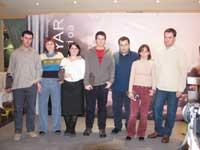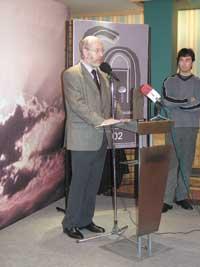Varied themes and young writers

“Kalamua: maria ren sekretua” wins the IX CAF-Elhuyar Award. the edition, according to the jury, “for fleeing from normal forms and simplicity and presenting the subject with clarity and precision without transmitting ideological positions”. Aitziber Mendiguren, Joseba Pineda and José Ángel Ruiz, of the Faculty of Medicine of the UPV/EHU, have clearly indicated what are the useful and beneficial aspects that can have the pharmacological content of cannabis, as well as the negative aspects. As in the case of the explanation of any other drug, historical, biochemical and physiological aspects have been addressed, always maintaining an adequate scientific level and without falling into simplifications. “Practical, legible, well classified and informative article”, according to the jury.
The second prize went to the work that analyzes the situation of the beech trees in Nafarroa Garaia. One of the objectives of the CAF Elhuyar Awards is to disseminate the results of their research and so has this work, which has been awarded the second prize. Gustavo Amores Olazagirre has shown with great precision the situation of the beech trees of Nafarroa Garaia. The results of fieldwork has brought them to paper, but it has not been limited to it.

The conclusions of these works have been clear and have made known how it has been and can be the entrance of pollution in those beautiful places.
The jury stressed that this research has provided an idea about the situation of our natural spaces and that, even if it is from here, to a large extent, the scientific seriousness and the desire for disclosure that this work shows is something omnipresent.
The third prize went to Cleopatra, Perle and Luxury, “because, addressing a simple theme, writers have managed to make a nice craft, bringing pearls closer to the level of quantum physics.” The jury has qualified as a round work “to distribute at school or to read in bed or in the bathroom with your partner. To a teaching and entertainment that does well the dissemination of science.” This was assessed by Itxaso Apraiz and Ohiane Lakar, biology students. Despite the third prize, this article collects the best flowers.
Special prize for young writers
The special prize for young writers has been awarded for Gorka Azkune’s work “The Hidden Children of Nature”. This young twenty year old computer student has not just begun to divulge, since in the last edition he won the second prize. He then presented the important and difficult superstring theory in an elegant, attractive and understandable way. This year Gorka has addressed another issue that is no easier, the theory of black holes. “He has carefully presented the theory of black holes, that of stars that cannot be observed directly. How they anticipated, the recognition of their existence, some of the characteristics that are known today, the phenomena that are explained through them... And, of course, the doors that open for the future: singularities, time machines, trips in hyperspace…”.

All this with the explanation of Einstein's Theory of General Relativity, which began this long journey that has not yet concluded. The jury valued the current issue, the quality of the scientific content and the style of the Basque language used, “the simple and comprehensive presentation of a hard and heavy topic”.
In this year's call, a total of 17 articles have been presented, all of them of good quality according to the jury. The jury praised the quality of the works and the youth of the writers, but also asked them to take more care of their graphic facet and their informative style. More than one has lost the prize. A satisfactory critique to a large extent, since it represents another step in scientific disclosure.





